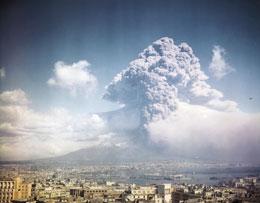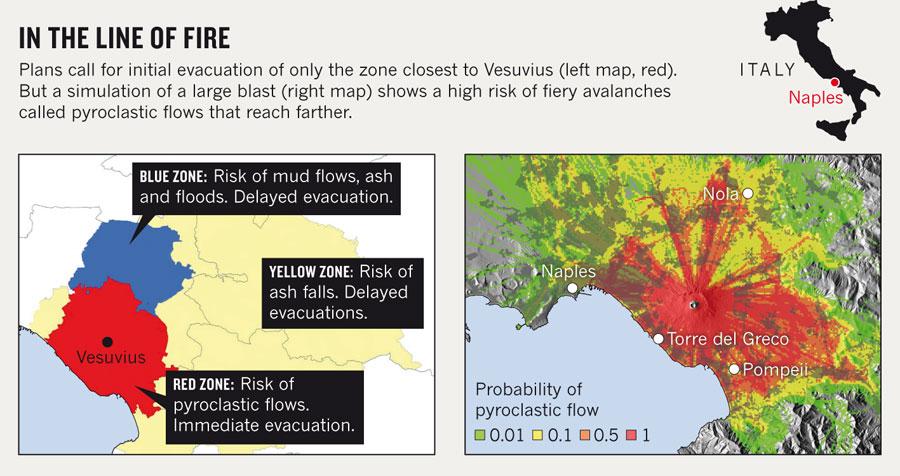Europe’s ticking time bomb
Volcanology: Europe’s ticking time bomb
Vesuvius is one of the most dangerous volcanoes in the world — but scientists and the civil authorities can’t agree on how to prepare for a future eruption.
Katherine Barnes
It starts with a blast so strong that a column of ash and stone rockets 40 kilometres up into the stratosphere. The debris then drops to Earth, pelting the surface with boiling hot fragments of pumice and covering the ground with a thick layer of ash. Roofs crumble and vehicles grind to a halt. Yet the worst is still to come. Soon, avalanches of molten ash, pumice and gas roar down the slopes of the volcano, pulverizing buildings and burying everything in their path. Almost overnight, a packed metropolis becomes a volcanic wasteland.
This is Naples, Italy, in the throes of a cataclysmic eruption of Vesuvius — the volcano that destroyed the city of Pompeii in AD 79. The scenario may sound far-fetched, but in the wake of Japan’s recent earthquake and tsunami, many areas are reassessing the risks from their own ’black swans’, a term used to describe unlikely but potentially devastating disasters. And Naples stands out as particularly vulnerable, with a population of 3 million living in the shadow of Vesuvius.
The volcano has been eerily dormant since a small eruption in 1944, but recent studies suggest that Vesuvius could be more dangerous than previously assumed, which has prompted a vigorous debate about the risk and scale of future disasters. Local authorities face the difficult task of deciding how to protect a large population in the event of earthquakes and other signs heralding the volcano’s reawakening. "There would be no modern precedent for an evacuation of this magnitude," says Giuseppe Mastrolorenzo at the Vesuvius Volcano Observatory in Naples. "This is why Vesuvius is the most dangerous volcano in the world."
Rumblings of dissent
The slumbering giant won’t stay quiet forever. Seismic imaging studies have detected an unusual layer about 8–10 kilometres deep under the mountain’s surface. Mastrolorenzo and his colleague Lucia Pappalardo interpret this layer as an active magma reservoir [1], which could produce large-scale ’plinian’-style explosions — named after Pliny the Younger, who described the AD 79 eruption.
The first rumblings of activity at Vesuvius could come weeks to years before an eruption, but there might be little, if any, warning of the eruption itself. Pappalardo and Mastrolorenzo analysed the geochemistry of rock fragments from past eruptions, and found evidence that magma ascended rapidly — in just a few hours — from its deep chamber to the surface.
 Vesuvius last awoke with a small blast in 1944. A large eruption could unleash incendiary avalanches and ash that would threaten millions of people.BETTMANN/CORBIS
Vesuvius last awoke with a small blast in 1944. A large eruption could unleash incendiary avalanches and ash that would threaten millions of people.BETTMANN/CORBISGiven these concerns, the Vesuvius observatory team has urged the Neapolitan authorities to base their emergency plan on a worst-case ’maximum possible’ eruption similar to the Bronze Age blast. "A crisis could start today," says Mastrolorenzo. "The trouble is that nobody would be able to tell how long it would last, what type of eruption it would be, or how the event would evolve." The researchers recommend the complete evacuation of an area 20 kilometres around Vesuvius if earthquakes and other signs of unrest hint that it is coming back to life.
Not all scientists share this doom-laden outlook. Some groups have even proposed that Vesuvius is becoming less explosive. Bruno Scaillet and his colleagues at the University of Orleans in France argue that the eruptive style of Vesuvius has changed as the magma chambers feeding the eruptions have migrated upwards, with the small 1944 eruption coming from a relatively shallow level 3 kilometres below the surface [3]. Evidence suggests the magma stored there is less viscous, so it is less prone to causing large explosions. If the past trend holds, says Scaillet, the next eruption could be similar to the most recent ones.
Scaillet adds that the seismically unusual layer 10 kilometres below the surface could be magma, but it could also be some other fluid such as water or brine. "These various issues are far from being settled," he says.
Emergency planning
With the size of any future eruption in doubt, and a public more concerned about day-to-day problems such as traffic and crime, mitigating the hazard of Vesuvius is an enormous task shared by researchers and the civil authorities.
Scientists keep constant tabs on Vesuvius through a network of sensors that monitor for earthquakes, ground deformation and changes in the chemistry of escaping gases.
And Italy’s Department of Civil Protection (DPC) maintains a National Emergency Plan for Vesuvius. The plan, first developed in 1995, is based on a scenario for an intermediate-sized eruption, similar to one that occurred in 1631. That sub-plinian blast killed 6,000 people but affected an area much smaller than the earlier plinian eruptions.

The plan divides the area around the volcano into three regions according to the type of hazard expected. The red zone, closest to Vesuvius, is deemed most at risk from pyroclastic flows, so the plan calls for the evacuation of all 600,000 residents in this area before an eruption starts (see ’In the line of fire’). The main danger in the yellow zone comes from falling ash and small rocks. Officials would wait until the eruption starts, and the wind direction is known, before ordering an evacuation of regions in yellow zones downwind of the volcano. The blue zone is at risk from floods and mud flows triggered by the eruption, and would be evacuated according to the same plan. The city of Naples was excluded from any of the hazard zones because the prevailing wind typically blows ash to the east, away from the city.
In 2003, the DPC announced that it would constantly update the emergency plan to take account of new scientific information. The red zone is being expanded to include the eastern districts of Naples and officials reduced the evacuation time from two weeks to 72 hours, recognizing that there may be less of a warning before the eruption.
“You need to reduce the risk in a rational way.” Nevertheless, some researchers argue that the plan has ignored important scientific evidence. Last year, Mastrolorenzo and Pappalardo [4] and Giuseppe Rolandi [5] of the University of Naples found that even with an intermediate-sized eruption, pyroclastic flows would threaten several municipalities not currently included in the red zone. Mastrolorenzo says that officials should also not wait to evacuate the yellow zone, because fine ash would rapidly fill the air and plunge the area into total darkness. "You have to get people out before it starts," he says. And the wind does sometimes blow towards Naples, so the authorities cannot rule out heavy ashfall in the city, say both Mastrolorenzo and Rolandi.
Putting all the evidence together, they and other researchers insist that the emergency plan should correspond to the ’worst-case scenario’, which means including metropolitan Naples and its 3 million inhabitants.
That makes sense for planning, says Jonathan Fink, a volcanologist at Portland State University in Oregon. Once the volcano shows signs of unrest, authorities and scientists can re-evaluate. "If there is an error on the high side, there is less lost than would be the case in the opposite situation," he says.
In a written response to Nature, the DPC advocates evaluating the eruption risk "on the basis of the present state of the volcano and not simply assuming the largest eruption event that ever occurred in the volcanic history". Some scientists agree. "You can’t spend [everything] on the absolute worst case. You need to reduce the risk in a rational way," says Warner Marzocchi at the National Institute for Geophysics and Volcanology (INGV) in Rome. A complete evacuation of Naples’ 3 million residents, he says, "would be impossible to manage".
Marzocchi and other researchers are developing modelling tools — based on the probabilities of different scenarios — that could help civil authorities evaluate the evidence during a crisis and choose a course of action. Peter Baxter, an expert in emergency planning at the University of Cambridge, UK, specializes in the impacts of volcanic eruptions and used this type of method successfully during the 1997 eruption in Montserrat in the Caribbean to predict which regions would be affected. A complete evacuation of the island was avoided.
For Vesuvius, Baxter and his colleagues have used geological data and models of eruptive processes to develop an ’event-tree’ to display the full range of possible eruptions [6]. If sensors on the volcano pick up signs of magmatic unrest, the analysis suggests a 70% probability of an explosive eruption but only a 4% chance of a catastrophic plinian one. The most likely event is a violent but smaller blast, like the one in 1944, with lava flows and moderate ash emissions.
For now, this kind of probabilistic approach seems the only way forward for volcanologists and disaster planners, as there is no recipe for accurate eruption forecasting on the horizon. "It’s an extremely complex problem to solve," says Augusto Neri of the INGV’s laboratories in Pisa. "We simply do not know how the volcano works."
Katherine Barnes is a freelance writer in London.
Published online 11 May 2011 | Nature 473, 140-141 (2011) | doi:10.1038/473140a
[1] Pappalardo, L. & Mastrolorenzo, G. Earth Planet. Sci. Lett. 296, 133-143 (2010).
[2] Mastrolorenzo, G. et al. Proc. Natl Acad. Sci. USA 103, 4366-4370 (2006).
[3] Scaillet, B., Pichavant, M. & Cioni, R. Nature 455, 216-219 (2008).
[4] Mastrolorenzo, G. & Pappalardo, L. J. Geophys. Res. 115, B12212 (2010).
[5] Rolandi, G. J. Volcanol. Geotherm. Res. 189, 347-362 (2010).
[6] Baxter, P. J. et al. J. Volcanol. Geotherm. Res. 178, 454-473 (2008).
